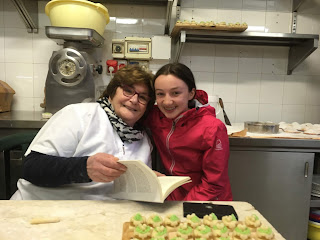This is Sicily
Daniel asked me to call back, saying, "I feel like I'm on the edge of a cliff making phone calls in Italian." I knew the feeling only too well. The previous morning, as I read student blogs in our hotel room, my phone rang and a woman started speaking to me in Italian once I picked up. I finally interrupted with, "Chi e?" (Who is it?") She started speaking to someone else whose voice I recognized: the dentist. When he got on, we spoke in some Italian and some English, and then Debra came back on the line to make the appointment for Mary's ortho check-up for April. Even picking up the phone had been scary for me.
But I said no. I couldn't call this woman again to ask her anything else, even if just where else we might go.
I heard Daniel say things like, "Veinte minuti...grazie." He had gotten the same woman on the phone, and she said that she'd wait for us.
At 6:20pm, we parked the car, spied the open door to the museum, and rushed in. She gave us a tour of the museum herself, showing us photos and parts of the old windmill; telling us that her grandfather had worked at these flats and run this organization; answering the kids' questions; explaining the process of the salt's being harvested with pride.
Sebastian said, "She seemed really happy to tell us all about the flats and salt and the place. Like she had pride in it and was happy to share it all."
This is Sicily.
 |
| Kids with our tour guide who stayed open for us at the Salt Museum in Trapani, Sicily |
----------------------------------------
Cannoli, pastries, coffee -- we sat with our treats with our new friends, the Canadian family we had met hours before. (They were traveling for the year.) Daniel went back to the counter to ask whether Mary might meet Maria Grammatico.
For the next fifteen minutes Mary remained in the back room, sitting with Maria Grammatico, who was decorating treats and even let Mary decorate one. Maria Grammatico and the other women at the table smiled affectionately at Mary when I came in and we asked to take a photo.
Before we left, Maria Grammatico gave Mary one of her cookbooks -- recipes made with almonds.
This is Sicily.
 |
| Mary with Maria Grammatico in the kitchen of her pasticceria in Erice |
--------------------------------------------
On a walk back to the hotel, we saw bouncy house type structures behind a theatre. Popcorn, candy, imitations of junk food that we'd get back in the states on the Waltham Common at this type of festival. The kids asked for popcorn and candy. I couldn't do it. I told them, "Let's go to Capo Market instead, and I will get each of you whatever you want from there."
"Anything?"
"Yes. Any food you want."
I had been curious about the outdoor food markets and didn't want to leave Palermo without getting to one. Student blogs revealed that Capo was better than Ballaro.
Five minutes and we were at a street lined on both sides with vendors: fish, fruit, vegetables, chocolate, arincini, cheese, bread, olives. Vendor after vendor.
Family treat: a chedro. A chedro is a huge lemon. I think this one cost 7.50. Mary carried it in a plastic bag while we sampled Modica chocolate -- the plain, the orange, the lemon, the chili pepper, the pistacchio (which reminds me of a tip we read to test the quality of a gelateria: check the color of the pistacchio gelato. If it's bright green, move on. If it's a darkish green, almost brown, you're in a good spot.). We buy Modica chocolate bars for all of us (how we can eat any more sugar is beyond me after gelato, morning croissants with nutella or cream, crostata, gelato...but we're in Sicily, and this is not the time to cut back on sugar or treats).
We discuss bringing the chedro to fish dinner that night. But we don't have a knife. The way to eat a chedro is in slices sprinkled with either sugar or salt. Mary returns to the vendor and asks if he will cut up the chedro for us. We watch, mesmerized by his speed and skill with the sharp knife. He packs it up in a bag for Mary.
She asks him, "Quanta costa?"
He says, "Niente."
When I ask whether we should give him some sort of tip anyway, Sebastian insists that we not. He imitates the gesture the man made that means, "Are you kidding? Dai! Come on!" It would be an insult to give him a tip: he was happy to cut the chedro up for us.
This is Sicily.
We discuss bringing the chedro to fish dinner that night. But we don't have a knife. The way to eat a chedro is in slices sprinkled with either sugar or salt. Mary returns to the vendor and asks if he will cut up the chedro for us. We watch, mesmerized by his speed and skill with the sharp knife. He packs it up in a bag for Mary.
She asks him, "Quanta costa?"
He says, "Niente."
When I ask whether we should give him some sort of tip anyway, Sebastian insists that we not. He imitates the gesture the man made that means, "Are you kidding? Dai! Come on!" It would be an insult to give him a tip: he was happy to cut the chedro up for us.
This is Sicily.
 |
| Sicilian at Capo Market cutting up chedro for Mary |
 |
| Careful, Mary! That knife looks sharp! |
 |
| And the final touch...into slices for pre-dinner snack... |
No comments:
Post a Comment